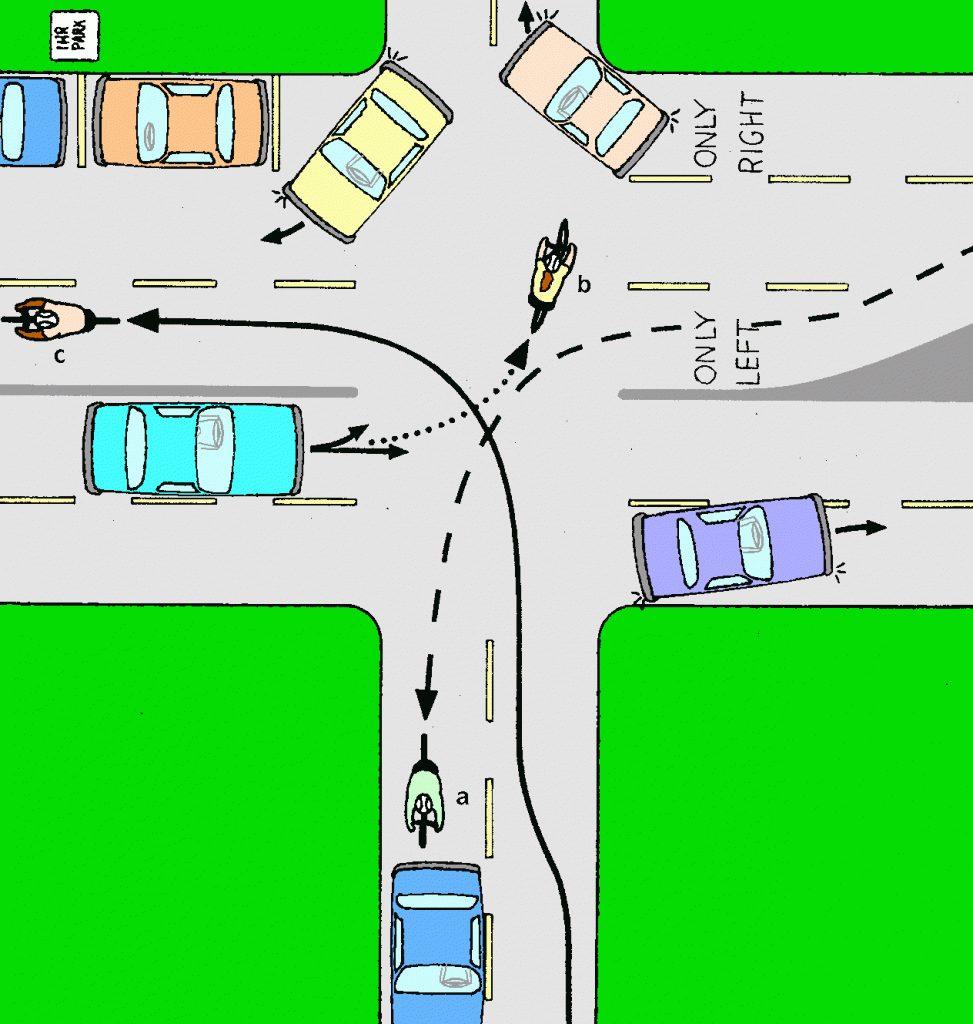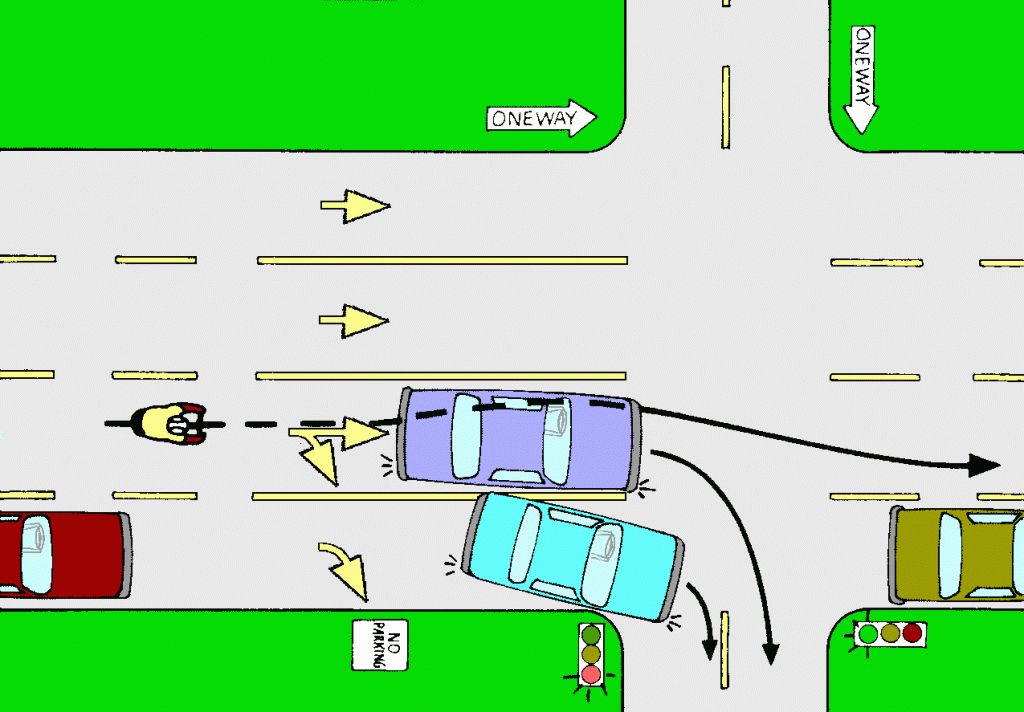Chapter 3
Riding Through Intersections
Intersections are where all of your traffic-riding skills come together. If you ride smoothly through the intersections, you can handle almost any riding environment.
At intersections, move to the correct lane position depending on which way you’ll be going. Often, you’ll need to move away from your normal position near the right side of the road. If you’re turning right, keep to the right. But if you’re turning left, move to the center of the road. If you’re going straight, go between the right- and left-turning traffic.
Right Turns
Right turns are easiest. Just stay in the right lane, look around for traffic and go around the corner. To avoid being squeezed against the curb, ride in the middle of the right lane if it’s narrow, just as you would on a straightaway. Remember that the rear end of a car cuts the corner as it makes a right turn.
At a stop sign or legal right turn on red, yield to traffic coming from the left on the cross street. You’re always required to yield to pedestrians in crosswalks. Bicyclists follow the same set of rules as motorists do.
A right-turn signal is a useful courtesy to drivers who would have to wait for you if you were going straight. Pointing with your right arm is the most effective right-turn signal.
Changing Your Lane Position
To prepare for most intersection maneuvers, you need to change your lane position. Even between intersections or when making a right turn, as just described, you may have to move farther toward the left side of the right lane. So far, we’ve gotten by with a quick description of how to look back and check for traffic.
But when making a left turn, you often have to move across more than one lane. It’s time to go into more detail. Before you change your lane position, you must always look back for traffic. Your sense of balance is in your head, so you need some practice to turn your head without swerving.
Some bicyclists change lane position without looking back, because they’re afraid of swerving. Don’t trust your ears! Many cars are very quiet, and a bicycle behind you is even quieter.
Practice looking back in an empty parking lot. Ride along a straight, painted line. Turn your head to glance back, and then look forward again to see whether you’re still riding straight. To keep from swerving, think about the position of your arms. If you don’t turn the handlebars, you won’t swerve.
Turn your head to look even if you have a rear-view mirror. A mirror can help you to keep track of the traffic directly behind you, but no mirror will show cars or bicyclists at your side.
The best way to look back depends on your riding position. If you’re sitting upright, swivel your neck and your back. If you’re in a low crouch, duck your head sideways. Some bicyclists even duck their heads underneath their arms.
Getting a Driver’s Cooperation
So now you’ve looked back. What next? If there’s a car close behind you, let that car go by, and deal with the next car.
Usually, the next driver will have time to react to your signals. If you make your intentions clear, the driver will almost always let you into line.
Extend your left arm to signal that you want to move to the left. Wait a couple of seconds, then look back again to check that the driver has slowed down or moved aside to make room.
Turning your head to look back is a signal, too. In slow, crowded traffic, you need to keep your hands on the handlebars, ready to brake. You can usually move into line with the cars while signaling only with a turn of the head.

Cross a lane in two steps; one to cross the lane line and the next to cross to the other side of the lane.
Whatever signal you use, do not change your lane position until you’re sure that the driver has noticed your signal and made room for you. Most drivers will, but there’s no guarantee. Your signal doesn’t make it safe to change lane position. Only the driver’s response to your signal makes you safe.
If you plan your lane change early enough to have a second opportunity, you’ll almost always succeed; if the first driver doesn’t make room for you, the second one almost certainly will. So anticipate turns and plan for them in time.
In high-speed highway traffic, drivers may not have time to react to you. Then you need to wait for a gap in the traffic and move across all of the lanes at once.
Left Turns
To prepare a left turn, change lanes until you reach the left-turn position in traffic. As you move toward the center of the street, this is where no cars on your left will go straight ahead. If the lane carrying left-turning traffic also carries through traffic, ride at its middle or left side. If it’s a left-turn-only lane, ride on its right side, or at its middle if it is narrow. On an ordinary two-lane street, turn left from just to the right of the centerline.
It may seem dangerous to move to the middle of the street, but in fact, the middle is the best position for a left turn. When you’re in the correct position, all the traffic you have to deal with is in front of you. Since you’re to the left of the through traffic coming from behind you, you are free to look ahead while deciding when it is safe to start your left turn. You can concentrate on the traffic from the left, right and front.
You may have to cross more than one lane to reach the left-turn position. Cross each lane in two steps. With one step, cross the lane line so you’re just inside the next lane. With the next step, cross to the far side of the lane. At each step, look back and get a driver to make room for you.
When in position for your turn, yield to traffic from the left, right and straight ahead. So you don’t have to come to a stop, you may move slowly out to the middle of the intersection, the same way cars do. Then you can get moving faster when there’s a gap in the traffic.
If you don’t make it to the left-turn position by the time you reach the intersection, don’t force the situation. Go straight through the intersection. Make your left turn at the next intersection, or cross to the other side of the street, double back and make a right turn.

Correct paths for left turns: Left-turn-only lane: bicyclist (a) has turned left from near the middle of a narrow left turn lane. Left-and-through lane: Wait for a traffic light near the middle of a left-and-through lane, so a motorist won’t sneak past on the wrong side. Bicyclist (b) has turned left from the left middle of a left-and-through lane. No special turn lane: bicyclist (c) turns from near the centerline of a two-way, two-lane street and enters the inner lane of a four-lane street to avoid right-turning car entering the outer lane.
As you approach the intersection, signal as much as comfortable to discourage straight-through motorists from crossing the centerline and passing on your left. When waiting close to the centerline you may also make a slow signal with your right hand as needed to discourage a left-turning motorist from creeping up on your right. As you enter the intersection, ride straight ahead a short distance so left-turning motorists waiting behind you can pull to your left. As you start to turn, take a quick look back in case a straight-through motorist is about to pass you on your left. Pass an oncoming left-turning car right side to right side.
It’s also okay to make a left turn as a pedestrian. This way, you can turn left legally at a “no left turn” sign or handle traffic situations you feel are beyond your abilities. At the far right corner of the intersection, come to a complete stop. Do not swerve left; it’s never safe because you would have to look for traffic in all four directions at once. Instead, stop and walk to where you can safely reenter the traffic flow.
Going Straight Through
Going straight through an intersection is easy compared with a left turn. You may have to change lanes, but not usually as many.
When preparing to go straight through, stay out of a right-turn lane or at least, keep to its left side. Make sure right-turning traffic passes you on your right. You may sometimes have to merge into the second or third lane from the curb to avoid the right-turning traffic. Don’t be lulled by a bike lane to stay to the right of right-turning traffic.

Pass on the left of right-turning traffic when going straight through an intersection. Do not go to the right of traffic unless you are turning right.
Where cars are waiting for a stop sign or traffic light, never pass the first car. You never know for sure when or in which direction that car will move. Besides, while you’re passing the car, it may hide a pedestrian or other hazard.
The most difficult intersection to ride straight through is the one that looks simplest – on a small, two-lane street. Traffic in the right lane goes in three different directions – right, straight and left! Still, on a street with parallel parking, the empty space between the parked cars and the corner serves as a right-turn lane. Don’t wander right, into this space. Keep going straight ahead.
On a street without parking, pull a little farther into the lane to discourage right-turning drivers from passing you on the left. With a little finesse, you can position yourself just far enough from the curb so cars can pass you on the right to make a legal right turn on red.
Some motorists hesitate to pass between a bicyclist and the curb to make a right turn. A friendly wave with your right hand tells them you don’t mind.
Summary
You can ride smoothly and confidently through most intersections. Correct lane position is the key. Plan ahead to change lanes well in advance if needed, especially for left turns. Even when going straight, you often need to adjust your position to avoid conflict with right-turning traffic. Your practiced ability to look back for traffic is essential. Using the correct lane position keeps you visible and gets you to where you can concentrate on traffic in front of you as you enter the intersection. Be sure to stay alert for drivers who fail to signal, fail to yield, or change their mind about which way to go.

I haven’t figured out yet how to format captions in WordPress. If the illustration is centered, so is the caption. That is particularly a problem with multiline captions. Reviewers, please ignore it because it won’t happen in the print version and we will probalby find a solution in the Web version even if we use WordPress.
In the “Going straight through” paragraph, perhaps mention “coffin corner” bike lanes, with a note to “See the next chapter about bike lane hazards.”